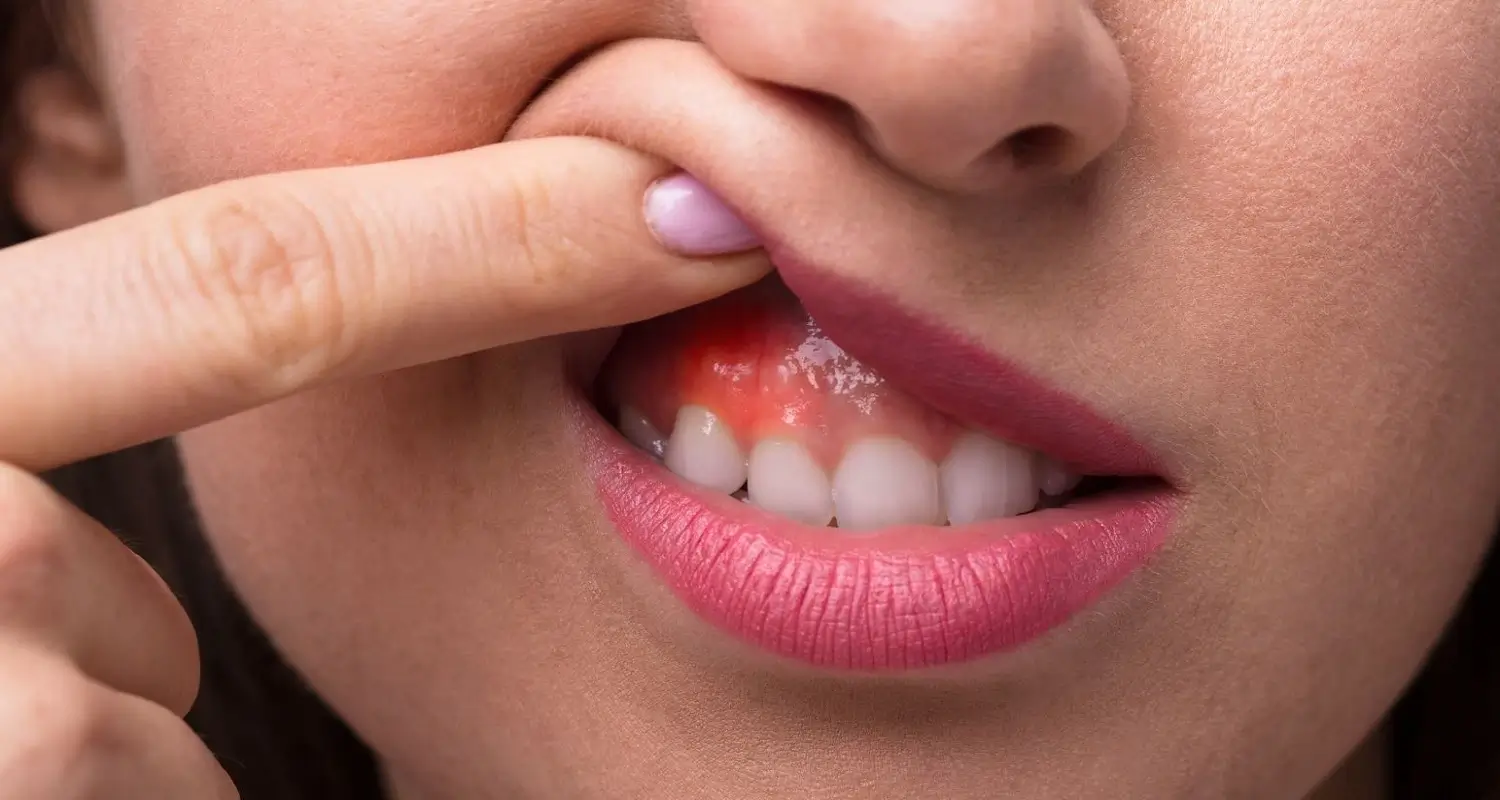Last Updated on: 19th September 2025, 12:49 pm
Did you know that gums can also become diseased? Much is said about the importance of dental hygiene to prevent cavities, but little is heard about the stages of gum disease. The truth is that oral health not only involves having shiny, cavity-free teeth but also maintaining healthy gums. When gums become diseased, there are progressive alterations that occur in various stages.
What are Gum Diseases?
Teeth have a visible part (the crown) and an unseen part (the root). The roots of the teeth are submerged in areas of the upper and lower jawbones called alveolar ridges. These ridges are covered by a soft, pink tissue called gums. When gums become diseased and inflamed, the tissues that support the tooth are generally affected, which can lead to various problems, including tooth loss.
What causes Gum Disease?
Although several factors can contribute to the development of gum disease, the main cause of it is bacterial plaque, both soft and calcified.
Dental Plaque: What You Need to Know
Dental plaque is a layer of food and organized bacteria that adheres to teeth and remains there for an extended period. When the body detects dirt on the dental surface, it initiates a defense mechanism against bacteria, causing inflammation of the gums. There are two types of dental plaque:
• Soft plaque: This is plaque that has recently formed and can be removed with a toothbrush and dental floss.
• Calcified plaque or tartar: When soft plaque is not removed for a long time, it acquires minerals from the environment and hardens. This plaque firmly adheres to teeth, and specialized dental instruments and equipment are required to remove it.
The accumulation of dental plaque can be facilitated by various factors, including:
• Poor oral hygiene: When plaque is not removed from all dental surfaces.
• Dental crowding: When teeth are too close together or crooked, oral hygiene becomes difficult.
• Salivary problems: Saliva helps clean teeth, but if it is insufficient, plaque accumulation is favored.
Other causes of gum disease:
Although dental plaque is the primary factor in developing gum disease, it is not the only one. Other factors that can cause gum disease are listed below:
• Hormonal changes: States that involve hormonal changes such as menopause, puberty, pregnancy, or menstruation can make gums more susceptible to inflammation.
• Smoking: Cigarettes contain nicotine, which decreases blood circulation in the gums, negatively affecting tissue response to infections.
• Consumption of certain medications: Many studies have described how medications can affect oral health, as some decrease saliva flow, which under normal conditions has a protective effect on teeth and gums. Others can cause abnormal growth of gum tissue, such as phenytoin.
• Immune system diseases: Many pathologies can affect the immune system, including lupus, cancer, HIV infection, arthritis, and/or diabetes, among others. A deteriorated or overly active immune system does not respond adequately to infections, causing gums to deteriorate more rapidly.
• Genetic predisposition: Patients with a family history of gum disease are more likely to suffer from this condition.
• Advanced age: Deterioration of the immune system, motor difficulties, and dental loss can be factors that increase the risk of gum disease in older adults.
• Dental loss: When teeth are lost, spaces are left where plaque accumulates more easily, causing damage to the gum and bone that support adjacent teeth. Additionally, when the number of teeth decreases, those that remain must bear the entire load of chewing, weakening and affecting the bone and gum that support them.
• Bruxism: Some people clench their teeth, overloading supporting tissues, which can cause or worsen gum disease.
What are Gingival Recessions?
When gums recede and expose part of the roots of the teeth, dentists refer to this as gingival recessions. They can happen as a result of gingival inflammation that was not addressed in time or due to other factors, such as horizontal tooth brushing or bruxism. Gingival recessions are an alarming sign, as they represent a loss of tooth support. They can also cause dental sensitivity since they leave the dental roots exposed to stimuli such as cold and heat.
Stages of gum disease
Gum disease has two main stages: gingivitis and periodontitis. Depending on their severity, periodontitis can be mild, moderate, or severe. Below are the signs and symptoms of each stage:
Gingivitis
It is the initial phase of gum disease. It presents as an inflammation limited to the gums, where there is still no loss of tooth support. It is characterized by:
• Gingival bleeding
• Red and swollen gums
• Mild sensitivity.
Periodontitis
Periodontitis is a gum disease that occurs when gingivitis is not treated in time, causing the infection to spread beneath the gum and into the bone. In such cases, the gums “separate” from the teeth, forming spaces or pockets called periodontal pockets. Bacteria accumulate in these pockets, causing an infection that continues to destroy the gum and bone. When this happens, there is a loss of dental attachment.
Depending on its severity, periodontitis can be classified into four stages:
Stage 1 (Mild periodontitis):
• Loss of dental attachment
• Periodontal pockets are shallow, between 1 and 2 mm.
• Mild gum recession
• Teeth have a slight degree of mobility
Stage 2 (Moderate periodontitis):
• Moderate loss of dental attachment
• Teeth may be mobile
• Moderate gum recession
• There may be pain and discomfort
• Gums recede, exposing the roots of the teeth and causing them to loosen.
Stage 3 (Severe periodontitis):
• Considerable loss of bone and gum tissue that support the tooth
• Advanced tooth mobility that may lead to tooth loss
• Severe gum recession
• There may be pain, abscesses, or pus drainage.
Stage 4 (Very severe periodontitis):
• More than 4 teeth have already been lost due to periodontitis
• Severe tooth mobility in several teeth
• Severe gum recession
• There may be pain, abscesses, or pus drainage.
Treatment of Gum Disease
Depending on the diagnosis and stage of gum disease, there are several treatment options available that can stop its progression and prevent tooth loss. Typically, treatments focus on deep cleanings to remove plaque bacteria, control inflammation, and disinfect periodontal pockets, which aids in tissue healing and helps the gum reattach to the tooth. Similarly, when too much attachment has already been lost, there are treatments available that can help restore support to the tooth through the use of grafts.
Frequently Asked Questions
How Fast Does Gum Disease Progress?
Periodontal disease progresses gradually yet steadily. Plaque buildup can peak within just four days, with visible signs of gingivitis appearing by day five. If left untreated, gingivitis can advance to more severe periodontal disease within a matter of weeks.
What Does Stage 4 Gum Disease Look Like?
Stage 4: Progressive Periodontitis
In the final stage of gum disease, there is significant bone loss, ranging from 50 to 85 percent of the tooth root. This stage is characterized by loose and shifting teeth, red, swollen, and painful gums, and often the formation of abscesses.
Can I Live a Long Life with Gum Disease?
It is possible to live a long life with periodontal disease if you properly manage the condition with the help of your dentist. Early treatment is crucial, as it increases the likelihood of successfully treating gum disease and improving your overall quality of life.
What is the Fastest Way to Heal a Gum Infection?
If you’re looking for the quickest way to treat a gum infection, a powerful home remedy is salt water. As a natural disinfectant, salt water helps heal inflamed gums by eliminating harmful bacteria and reducing bad odor.
Share:
References
1. Factores de riesgo de la enfermedad de las encías. (7 de febrero de 2020). Academia Americana de Periodoncia. https://www.perio.org/for-patients/gum-disease-information/gum-disease-risk-factors/
2. Prevención de la enfermedad de las encías. (8 de febrero de 2020). Academia Americana de Periodoncia. https://www.perio.org/for-patients/gum-disease-information/gum-disease-prevention/
3. Enfermedad de las encías y otras enfermedades. (21 de junio de 2019). Academia Americana de Periodoncia. https://www.perio.org/for-patients/gum-disease-information/gum-disease-and-other-diseases/
4. Tratamientos no quirúrgicos. (21 jun, 2019). Academia Americana de Periodoncia. https://www.perio.org/for-patients/periodontal-treatments-and-procedures/non-surgical-treatments/
5. Enfermedades periodontales. (s. f.). Johns Hopkins Medicine. https://www.hopkinsmedicine.org/health/conditions-and-diseases/periodontal-diseases
6. Troncoso, C. M., Castillo-Ruiz, M., Daille, L. K., Fuentevilla, I. A., & Bittner, M. (2010). Co-detección de patógenos periodontales en pacientes chilenos con periodontitis crónica. Revista clínica de periodoncia, implantología y rehabilitación oral, 3(3), 118-122.
7. Papapanou, P. N., Sanz, M., Buduneli, N., Dietrich, T., Feres, M., Fine, D. H., Flemmig, T. F., Garcia, R., Giannobile, W. V., Graziani, F., Greenwell, H., Herrera, D., Kao, R. T., Kebschull, M., Kinane, D. F., Kirkwood, K. L., Kocher, T., Kornman, K. S., Kumar, P. S., . . . Tonetti, M. S. (2018). Periodontitis: Informe de consenso del grupo de trabajo 2 del Taller mundial de 2017 sobre la clasificación de enfermedades y afecciones periodontales y periimplantarias. Journal of Periodontology, 89, S173-S182. https://aap.onlinelibrary.wiley.com/doi/10.1002/JPER.17-0721
-
Nayibe Cubillos M. [Author]
Pharmaceutical Chemestry |Pharmaceutical Process Management | Pharmaceutical Care | Pharmaceutical Services Audit | Pharmaceutical Services Process Consulting | Content Project Manager | SEO Knowledge | Content Writer | Leadership | Scrum Master
View all posts
A healthcare writer with a solid background in pharmaceutical chemistry and a thorough understanding of Colombian regulatory processes and comprehensive sector management, she has significant experience coordinating and leading multidisciplina...



















